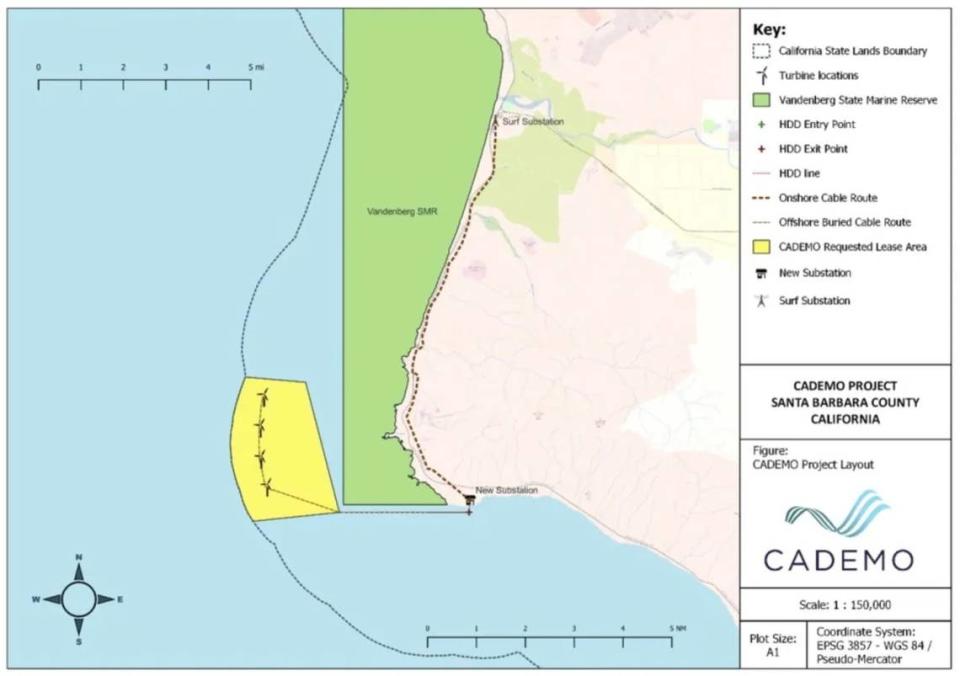Offshore wind energy farm near Vandenberg would be California’s first. Here’s what to know
Installation of four floating wind-turbine generators in the Pacific Ocean near Vandenberg Space Force Base — as soon as 2027 — are aiming to usher in an era of offshore wind energy on the West Coast, according to a project representative.
“We’re really excited that as California’s first floating offshore wind farm, we will be setting the standard for California offshore wind energy,” said Robert Collier from Cierco US Energy Corp..
Cierco has partnered with SBM Offshore to create Floventis Energy for the local project, which has been dubbed CADEMO, Collier said.
In 2021, the California State Lands Commission accepted the application and agreed to conduct a full-blown environmental impact report on the proposal for the ocean off the southern coast of Vandenberg, near Lompoc.
The State Lands Commission expects to kick off the environmental impact study this year with release of a notice of preparation, but does not have a time period for when it will happen, a representative said.
That will start procedures to begin collecting comments about what issues should be analyzed in the document.
“That will be a significant milestone for the project, and will invite public participation to comment on the project,” Collier told Noozhawk. “We look forward to engaging more formally with the community, and really helping design the project in a way most sensitive to the environment and the needs of the community.”

The State Lands Commission has selected Aspen Environmental Group as the consultant to spearhead the study.
Originally, two applicants proposed wind energy projects off the coast of Vandenberg, but the State Lands Commission said the second firm withdrew its application in February.
CADEMO’s project could be operational by late 2027, Collier said during an EconAlliance forum about alternative energy held in Solvang in April.
The proposal involves four turbine generators on floating platforms about the size of a football field and moored to the seafloor about 2.8 miles from the Santa Barbara County shore.
Each would generate between 12 and 15 megawatts of electricity, for a maximum of 60 megawatts, or enough renewable electricity each year to meet the needs of the equivalent of 16,300 U.S. households.
The towers will stand 500 feet in the air with the blade tips extending up to 870 feet.
“These are almost the size of the Empire State building or the Transamerica Pyramid,” Collier said.

Electricity would be brought ashore at Vandenberg and eventually connect to an existing substation near Surf Beach. Power purchase agreements are pending, but Pacific Gas & Electric Co. and Vandenberg could be key customers.
The CADEMO project would occur in state waters, unlike larger proposals that are planned for federal waters off the coast of Morro Bay and Humboldt.
Offshore wind energy doesn’t occur yet on the West Coast, but projects exist on the East Coast and in Europe and Asia.
Wind energy projects planned for federal waters likely won’t be operational until the 2030s because the federal permitting process takes longer, Collier contended, estimating CADEMO will begin five years earlier.
The pilot project off Vandenberg will help demonstrate a number of factors, such as environmental research, tribal partnerships, fishing compensation, supply chain development, and more.
“Why here? Why off the coast of Vandenberg?” he asked, adding that the company found the area fit a number of different criteria, including having a suitable connection to the power grid.
Once the CADEMO turbines are in the water, officials expect to study various aspects for use in other offshore wind energy projects, including “what works, what doesn’t work in terms of reducing impact to fish and wildlife,” Collier said.
“We are proudly hoping to serve as a model for the rest of the offshore wind energy industry going forward in future years,” Collier said.
Offshore wind energy development proposed for SLO County
The CADEMO project isn’t the only offshore wind energy development proposed for the Central Coast.
Located about 20 miles off the coast of Cambria and San Simeon, the Morro Bay offshore wind energy area covers 376 square miles of the Pacific Ocean.
After an auction in December, three companies bid a collective $425.6 million to lease the area and build hundreds of 1,100-foot-tall floating wind turbines.
Those companies — Central California Offshore Wind, Equinor Wind US and Invenergy California Offshore — estimate they can generate a collective 6 gigawatts of electricity at peak production. That’s enough to power more than 2 million homes.
In comparison, the largest floating wind farm in the world — Equinor’s Hywind Tampen located off the coast of Norway — produces 88 megawatts of electricity. That’s just 1.5% of the Morro Bay wind energy area’s potential peak production.
The Morro Bay area offshore wind energy developments will require substantial port infrastructure, sparking concerns about whether San Luis Obispo County is equipped to support this new energy industry along its coast.
Floating wind turbines are expected to be in the ocean off the shores of SLO County by 2030, according to federal officials.
Noozhawk North County editor Janene Scully can be reached at jscully@noozhawk.com .


